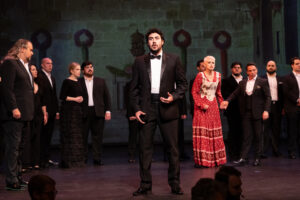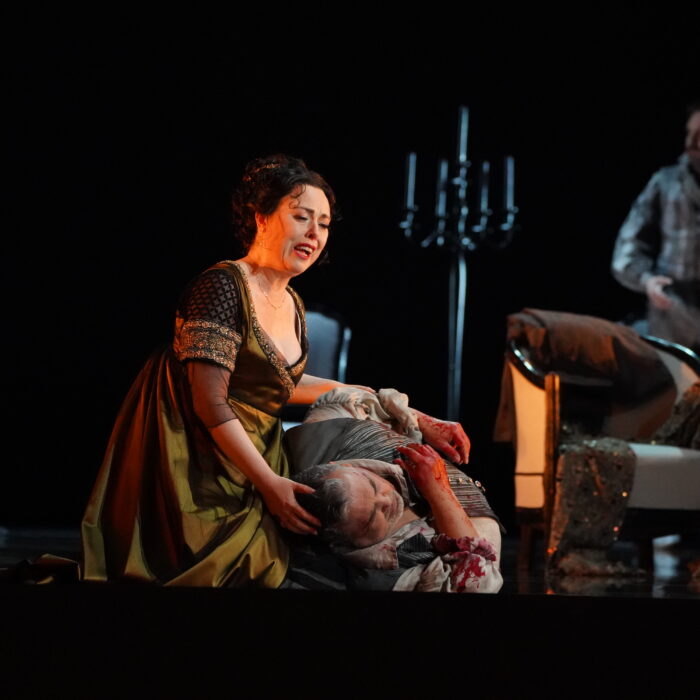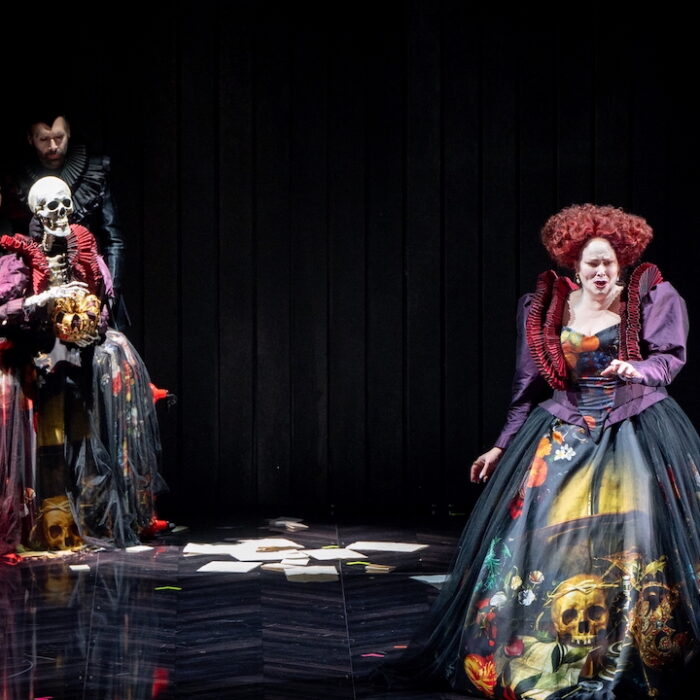
Teatro Nuovo 2024 Review: Anna di Resburgo
A Solid Cast Makes a Strong Case for Long-Forgotten Bel Canto Gem
By David SalazarIn the ongoing conversation about the future opera is a desire to move forward toward new works and the continued evolution of the work in contrast to the “canon.” But it’s rare for part of that conversation to encompass a reconsideration of forgotten works as a means of enriching our understanding of the art form. At least this is often the case at the largest and most renowned U.S. opera house.
But at Teatro Nuovo, rediscovering and rescuing forgotten works, and most importantly, their composers, is at the heart of what the company and its leader Will Crutchfield. While a look back at most previous seasons will feature a wealth of rare Rossini, Bellini, and Donizetti gems, the last two years have opened up the playing field. In 2023, the company paired Donizetti’s “Poliuto” with the Ricci brothers’ (Federico and Luigi) “Crispino e la Comare.” And this year, Bellini’s “I Capuleti e i Montecchi” was presented alongside Carolina Uccelli’s “Anna di Resburgo.”
Nailing Her Second Shot
“Anna di Resburgo,” only Uccelli’s second work, the story of warring Scottish families, so happened to premiere in the same city and year as Donizetti’s 56th opera, “Lucia di Lammermoor.” “Anna di Resburgo” got two performances and then was withdrawn from the stage and tossed aside. Ucceli never got to compose another opera again. Her first one is lost and “Anna di Resburgo” was fortuitously rediscovered by Crutchfield and given a second lease of life in the form of another two performances.
If we look at the pantheon of great composers and their first two operas, none of them are major staples of the canon. Verdi’s “Oberto” and “Un Giorno di Regno” barely register with even Verdi’s connoisseurs. Donizetti’s first opera, “Il Pigmalione,” a student composition, didn’t even get its first performance until 1960. Wagner famously rejected his first three operas.
So it was a minor miracle of sorts to hear Uccelli’s sophomore effort as a work brimming with invention, a strong grasp of form, and — which cannot be undermined when some of the great bel canto operas (“I Puritani” and “La Sonnambula” just to name two staples) lack one — a solid and clear libretto (the composer herself revised the original by Giovanni Battista Niccolini).
Told across two acts, the opera kicks off following the catastrophic murder of a major lord, presumably by his son Edemondo. However, in reality, his rival committed the act, framed Edemondo and told his own son Norcesto the truth on his deathbed. Norcesto, now in power and seeking to preserve his father’s honor, perpetuated the lie, forcing Edemondo to flee and abandoning his wife Anna and their son Elvino.
When the opera commences, Norcesto and his crew are on the hunt for Edemondo and Anna has hidden herself as a shepherdess in the home of a landholder Olfredo and his daughter Etelia. Her son is also in their custody, though she has kept her identity a secret. That all falls apart when Edemondo, also disguised as a shepherd shows up at Olfredo’s and everyone agrees to hide the family from harm. But at a party, Norcesto recognizes the boy to be Edemondo’s son and seeking to use him as bait orders him taken away. Anna reveals herself and is promptly taken away. In the ensuing act, Edemondo turns himself in to save his family and is sentenced to death. Anna begs for her husband’s life but it is ultimately Norcesto, far and away, the most complex and interesting character in the opera, who realizes that he must tell the truth. All ends well for everyone.
Brilliant Music
Norcesto is not only the most interesting character dramatically, but also musically. Throughout the opera, he is introduced with a trumpet and percussion march breaking through the tender music associated with the shepherds and countryside. His vocal line is robust and even heroic throughout his opening “Non vi sgomenti amici.” But slowly but surely, it is revealed that something is amiss with him and Uccelli introduces more gentle musical passages. We see this most prevalently in the epic duet confrontation with Anna during the second Largo sostenuto assai section, “Ah! che il core.” Here the vocal line, first introduced by the baritone, features 32nd note lines that hint at an anxiousness in his resolve. The music is soft and meditative and a far cry from the thunderous vocalization the two singers are asked to do in the first section, almost as if trading blows. But this sense of doubt comes to its fullest fruition in undeniably the most impactful scene of the entire opera – the “Scena e romanza Norcesto” in which he grapples with his demons, the line seemingly fragmented, shifting from the softest of piani (something rarely introduced in his vocal lines prior to this) to the most thunderous of fortes. It’s a riveting moment of a character in conflict with himself that deserves to hang with the greatest pages from the other great opera composers.
But it’s not like all the good stuff is reserved for Norcesto. The rest of the score is full of glorious melodic moments, especially Edemondo’s aria “La sorte barbara,” a glorious Andante affettuoso whose melody unspools with the breadth one would associate with Bellini. Anna gets a similarly potent opening aria in the first act, but is allowed to truly come into her power during the duet with Norcesto.
The orchestration is quite beautiful as well, feeling rather lush and in many instances, more involved than what one would customarily hear from Uccelli’s contemporaries (again, the Norcesto scene). Moreover, the preponderance of solo instrument passages (there’s a clarinet solo, a cello solo, a flute solo, and a trumpet solo) gives the musical texture a very unique feel.
But the other major touchstone of the piece comes in the form of Olfredo’s “patter” aria. A technique reserved for buffo operas, here it is used as a means of doling out the exposition relating to Edemondo’s trial. Instead of a lengthy recitativo that would draw out the lengthy monologue, Uccelli’s choice of a propulsive rhythmic piece represents another touchstone of the opera as a whole – a strong sense of pacing. The opera moves. And because the libretto is clear from scene to scene, it never drags or feels abrupt in its movement.
That’s not to say it’s a perfect masterpiece. It does feel abrupt in how it transitions at times from one musical moment to the next and some of the “faster” numbers start to blur into one another. The ending, especially after the musical coup de théâtre that is Norcesto’s scene, feels like an anticlimax.
A Strong Cast
In the title role of Anna, Chelsea Lehnea had a solid night overall. The role features a lot of exposed high notes and coloratura, with the opening solo numbers replete with A5 and Bb 5, as well as a number of even higher interpolated notes in the repeat of the cabaletta. In other instances, mainly the ensembles and the grand duet in the second act, Anna’s intensity is expressed by an increasing use of high notes to soar above the other vocalists. For the most part, when it came to this part of her range, Lehnea delivered with aplomb, her voice shining and strong in the upper range. And while she sang with great flexibility in the lower and middle range, with in the middle where she would often get covered by thicker interjections from the ensemble.
Despite this, her standout moment came in the duet “Ah Norcesto! ti ferma” where the soprano matched her adversary, interpreted by Ricardo José Rivera, phrase for phrase, her voice thundering in the space, growing with strength even throughout the opening exchanges. This scene was earth-shattering, the two singers sparring throughout growing more and more forceful in their vocal exchange, almost to a breaking point. When Rivera suddenly launched the Largo sostenuto assai, the tension was allowed to cease and time seemed to stop for a moment, only for the fire and passion the two singers brought to the previous section to return in the duet’s final passages.
Speaking of time stopping, tenor Santiago Ballerini did just that throughout his big aria, spinning one lengthy line after another with seemingly endless breath. Most impressive was how he would dip to the softest and most threadbare of piani while slowly building toward increasingly agitated fortes, the aria a farewell, but also a man fighting to not let go. You could feel that if this was the last thing that Edemondo was to sing, he was going to make it last as long as he could. In Ballerini’s elegant vocalism, you didn’t want it to end. The tenor’s ability to spin such glorious piani was apparent throughout the night, but so was his ability to switch gears and display a more heroic edge to his lyric tenor, thundering with heroism during the Allegro Risoluto “So che a morir io mi’incammino.” Also impressive was his physical poise throughout. While this was semi-staged production, of all the cast members, Ballerini felt like he was most immersed in portraying his character’s nobility through his physicality.
Rivera rounded out the main trio and arguably stole the show from everyone with a tremendous ability to clearly delineate Norcesto’s character arc. While he was unsteady early on, his thunderous voice seemingly warming up, he quickly held firm and managed to rocket his baritone into the hall with bravura. You could feel his Norcesto’s oppressive nature, his hunger for power. But as the story progressed and his guilt took over, Rivera’s voice softened, the booming quality from the opening, giving way to something grainier, earthier even, piani suddenly creeping into the line. By the time we got the aria, his voice whispered gloriously as he confronted his fears and ghosts. The score lays it out, but Rivera’s interpretative insight and execution gave it clarity and life.
Not to be overlooked were Lucas Levy as Olfredo and Elisse Albian as Etelia. Albian displayed a bright and glimmering soprano in her opening lines right at the start of the opera. Levy displayed a confident tenor throughout though intonation issues and seeming fatigue crept in over the course of his ingenious patter aria.
The opera was led by the duo of Elisa Citterio, the concertmaster, and cembalist Lucy Tucker Yates. It was a fascinating choice and historically appropriate for the experience. And while it mostly worked, there were instances of miscommunication with the singers that often created hairy moments. Nonetheless, their musical direction was a major reason why this opera created such a strong impression. There was a strong balance between “pit” and stage and clarity in terms of the lush textures throughout.
In all, there’s no denying that Uccelli’s “Anna di Resburgo” is a very good opera. In a world where composers like Donizetti could get 56 tries to deliver their first veritable masterpiece, Uccelli delivered a solid operatic work on her second try. Who knows how much more she would have done with more opportunities? What is clear is that this opera deserves more than four performances.


